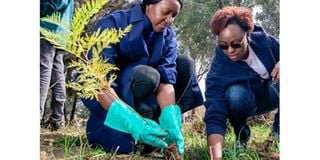KFS co-opts schools in efforts to restore tree cover in Kisumu, Siaya

People planting trees. Kenya Forest Service has co-opted schools in Siaya as part of the programme to tackle climate change.
The Kenya Forest Service (KFS) has launched a programme to mitigate the effects of climate change in Kisumu and Siaya counties by planting 100,000 trees annually.
Students will be given seedlings to plant and take care of at schools.
Ambrose Genga, a conservator and a KFS officer, said involving students would help the project become more successful.
“Most schools largely depend on trees as a major source of energy in cooking; this in essence has contributed to reduction of the tree cover in Siaya and Kisumu counties. This is the reason we are keen on sensitising the students on the importance of planting trees,” said Mr Genga.
He added, “We are keen to have the tree cover in the two counties increased. Again this will also instill the conservation mentality in our learners.”
The KFS has planted 13,000 trees in schools in Siaya and Kisumu counties.
In Siaya’s County Integrated Development Plan (CIDP), one million trees will be planted in five years.
Gazette hills
Besides planting trees, the county government was to gazette all the hills that are reserved for conservation and begin planting more indigenous trees.
“We are happy that the community and the schools that we have selected have received and owned the project. We also have the support of the county government that is working on a similar project,” said Mr Genga.
Siaya is ranked last in forest cover among counties in Kenya. It stands at only 0.4 percent.
Barding High School Principal Samuel Kaunda, whose students are part of the project, said it is timely and will be effective in conserving the environment.
“Schools have adequate space and ready labour to plant and to take care of the trees. We are happy that our school is implementing the project of climate change mitigation in Siaya,” said Mr Kaunda.
The KFS has also partnered with Pioneer Insurance company to sponsor the education of some needy and bright students.
Like other counties in the Western region, Siaya residents are decimating forests by harvesting trees and making charcoal from them.
“Ten thousand trees are lost every week in Western Kenya to charcoal burners; this has greatly affected the forest cover in the region. Most of the charcoal burners are harvesting the indigenous trees that are mainly found on the hills,” said Cynthia Odhiambo, director of the Lake Victoria Climate Change Mitigation Centre.




